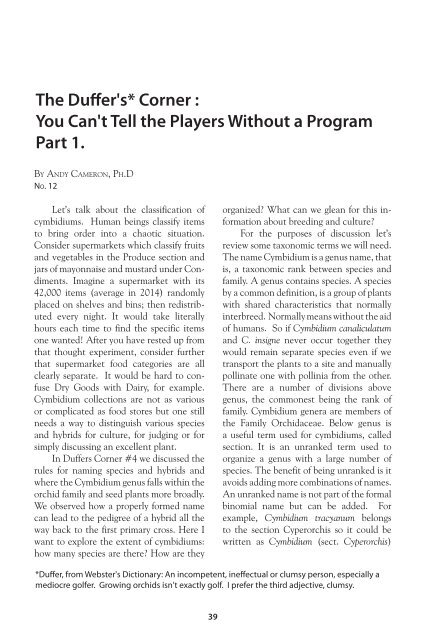CSA-Journal-2016-04
You also want an ePaper? Increase the reach of your titles
YUMPU automatically turns print PDFs into web optimized ePapers that Google loves.
The Duffer's* Corner :<br />
You Can't Tell the Players Without a Program<br />
Part 1.<br />
By Andy Cameron, Ph.D<br />
No. 12<br />
Let’s talk about the classification of<br />
cymbidiums. Human beings classify items<br />
to bring order into a chaotic situation.<br />
Consider supermarkets which classify fruits<br />
and vegetables in the Produce section and<br />
jars of mayonnaise and mustard under Condiments.<br />
Imagine a supermarket with its<br />
42,000 items (average in 2014) randomly<br />
placed on shelves and bins; then redistributed<br />
every night. It would take literally<br />
hours each time to find the specific items<br />
one wanted! After you have rested up from<br />
that thought experiment, consider further<br />
that supermarket food categories are all<br />
clearly separate. It would be hard to confuse<br />
Dry Goods with Dairy, for example.<br />
Cymbidium collections are not as various<br />
or complicated as food stores but one still<br />
needs a way to distinguish various species<br />
and hybrids for culture, for judging or for<br />
simply discussing an excellent plant.<br />
In Duffers Corner #4 we discussed the<br />
rules for naming species and hybrids and<br />
where the Cymbidium genus falls within the<br />
orchid family and seed plants more broadly.<br />
We observed how a properly formed name<br />
can lead to the pedigree of a hybrid all the<br />
way back to the first primary cross. Here I<br />
want to explore the extent of cymbidiums:<br />
how many species are there? How are they<br />
organized? What can we glean for this information<br />
about breeding and culture?<br />
For the purposes of discussion let’s<br />
review some taxonomic terms we will need.<br />
The name Cymbidium is a genus name, that<br />
is, a taxonomic rank between species and<br />
family. A genus contains species. A species<br />
by a common definition, is a group of plants<br />
with shared characteristics that normally<br />
interbreed. Normally means without the aid<br />
of humans. So if Cymbidium canaliculatum<br />
and C. insigne never occur together they<br />
would remain separate species even if we<br />
transport the plants to a site and manually<br />
pollinate one with pollinia from the other.<br />
There are a number of divisions above<br />
genus, the commonest being the rank of<br />
family. Cymbidium genera are members of<br />
the Family Orchidaceae. Below genus is<br />
a useful term used for cymbidiums, called<br />
section. It is an unranked term used to<br />
organize a genus with a large number of<br />
species. The benefit of being unranked is it<br />
avoids adding more combinations of names.<br />
An unranked name is not part of the formal<br />
binomial name but can be added. For<br />
example, Cymbidium tracyanum belongs<br />
to the section Cyperorchis so it could be<br />
written as Cymbidium (sect. Cyperorchis)<br />
*Duffer, from Webster's Dictionary: An incompetent, ineffectual or clumsy person, especially a<br />
mediocre golfer. Growing orchids isn't exactly golf. I prefer the third adjective, clumsy.<br />
39


